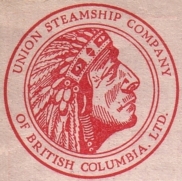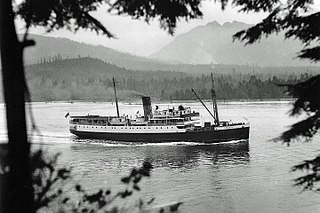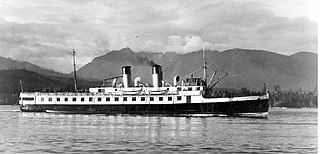
SS Catala was a Canadian coastal passenger and cargo steamship built for service with the Union Steamship Company of British Columbia.

Asbury Park was a high-speed coastal steamer built in Philadelphia, and intended to transport well-to-do persons from New York to summer homes on the New Jersey shore. This vessel was sold to West Coast interests in 1918, and later converted to an automobile ferry, serving on various routes San Francisco Bay, Puget Sound and British Columbia. This vessel was known by a number of other names, including City of Sacramento, Kahloke, Langdale Queen, and Lady Grace.

The Union Steamship Company of British Columbia was a pioneer firm on coastal British Columbia. It was founded in November 1889 by John Darling, a director of the Union Steamship Company of New Zealand, and nine local businessmen. The company began by offering local service on Burrard Inlet near Vancouver and later expanded to servicing the entire British Columbia coast.

For more than 35 years, from 1923 to 1958, the Union steamship Cardena sailed the British Columbia Coast, carrying passengers, groceries, dry goods, industrial cargo, mail and sundry other supplies to the 200 or so mining, logging and fishing communities that once dotted the province's coastline during the early years of the 20th century. On her return voyage, at the peak of the summer fishing season, Cardena routinely carried thousands of cases of canned salmon to the railheads at Prince Rupert and Vancouver for shipment across Canada and around the world. And so it went for the better part of half a century; a regular and reliable marine service that made Cardena a coastal institution, remembered with affection and regard by the countless men, women and children who inhabited those tiny outports in a bygone era.

Tacoma was a steamship that served from 1913 to 1938 on Puget Sound. Built of steel, Tacoma was known for being one of the fastest and best-designed vessels to operate on Puget Sound. Tacoma was particularly noted for high-speed service from 1913 to 1930 on the route between Tacoma and Seattle.

The river sternwheeler Ramona operated from 1892 to 1908 on the Willamette River in Oregon, on the Stikine River running from Wrangell, Alaska into British Columbia, and the Fraser River, in British Columbia. This vessel should not be confused with the coastal steamship Ramona which also ran in Alaskan waters.

Capilano was a steamship built in 1920 in British Columbia, which served until 1949.

Comox was a steamship built in 1891 in British Columbia which served until 1920. Comox was the first steel ship built on the west coast of North America north of San Francisco.

Cutch was a steamship built in 1884 in Hull, England. The ship served as a pilgrimage vessel and a yacht in India from 1884 to 1890, then as a steamship in British Columbia from 1890 to 1900 under the ownership of the Union Steamship Company. The ship was wrecked in August 1900, then salvaged and registered in the United States as Jessie Banning. In 1902 the ship was transferred to the navy of Colombia where it was armed with cannon and served in the Colombian navy as the gunboat Bogota. Bogota shelled the city of Panama on November 3, 1903 during the secession of Panama from Colombia.

Lady Alexandra was a steamship built in 1924 in Montrose, Scotland which served in British Columbia from 1924 to 1952, mostly on Howe Sound.

Cheslakee was a steamship that operated from 1910 to 1913 under the ownership of the Union Steamship Company of British Columbia. In 1913, the ship sank, killing seven people. This was the only accident involving a passenger fatality in the 70-year history (1889-1959) of the Union Steamship Company. Following the sinking Cheslakee was raised, reconstructed, and launched again under a different name.

Cowichan was a steamship which was operated in British Columbia under the ownership of the Union Steamship Company. Cowichan sank in 1925 following a collision with another ship.

Princess Beatrice was a steamship built for and owned by the marine division of the Canadian Pacific Railway (CPR). The ship served from 1903 to 1928 in the coastal waters of British Columbia. The ship also operated on Puget Sound on a route from Victoria, British Columbia to Seattle, Washington. Princess Beatrice was the first ship to operate in the year-round steamship service between Seattle and Victoria that was run by CPR from 1904 to 1959. This ship should not be confused with an earlier Princess Beatrice, built in Scotland in 1874, which served on the Atlantic coast of Canada.

Princess Royal was a wooden steamship built in 1907 for the Canadian Pacific Railway Coast Service. The ship operated on the coasts of British Columbia, south east Alaska, and northern Puget Sound until 1933, when the ship was sold for scrapping.

Princess Louise was a sidewheel steamboat built in 1869. From 1869 to 1879 this ship was named Olympia. In 1879 the name was changed to Princess Louise, after Princess Louise, Duchess of Argyll, a daughter of Queen Victoria who was married to Marquess of Lorne (1845-1914), Governor General of Canada from 1878 to 1883. Princess Louise was the last sidewheeler to be operated commercially on the coast of British Columbia.

Camosun was a steamship built in 1904 in Paisley, Scotland which served in British Columbia.

Lady Cynthia was a steel-hulled passenger ship converted from a minesweeper,, which served in the coastal waters of British Columbia from 1925 to 1957. Lady Cynthia was a sistership to Lady Cecilia, also a converted minesweeper. The ship was generally referred to as the Cynthia while in service.

Chelosin was a steel-hulled, steam-powered passenger-freighter vessel that served in coastal British Columbia from 1911 to 1949, under the ownership of the Union Steamship Company of British Columbia.

Chasina was an iron-hulled, steam-powered ship, originally built as a steam yacht, but later converted to a passenger-freighter vessel that served in coastal British Columbia and other areas during the early decades of the 1900s under the ownership several different companies. The ship disappeared in 1931 after leaving Hong Kong.

SS Prince George was a passenger ship built in 1947 for the Canadian National Steamship Company, to ply the route from Vancouver, British Columbia, to Southeast Alaska.




















